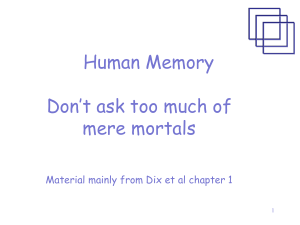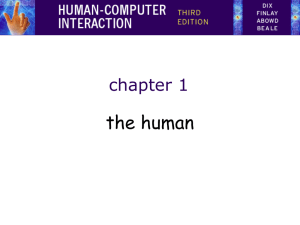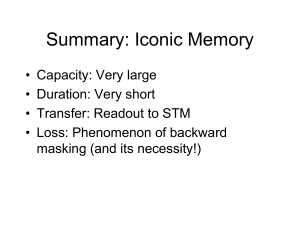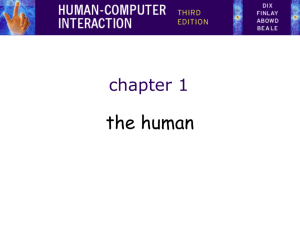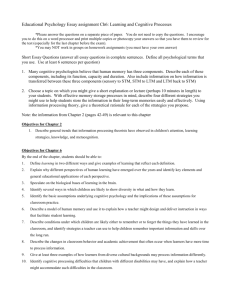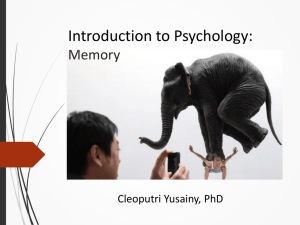What is HCI?
advertisement
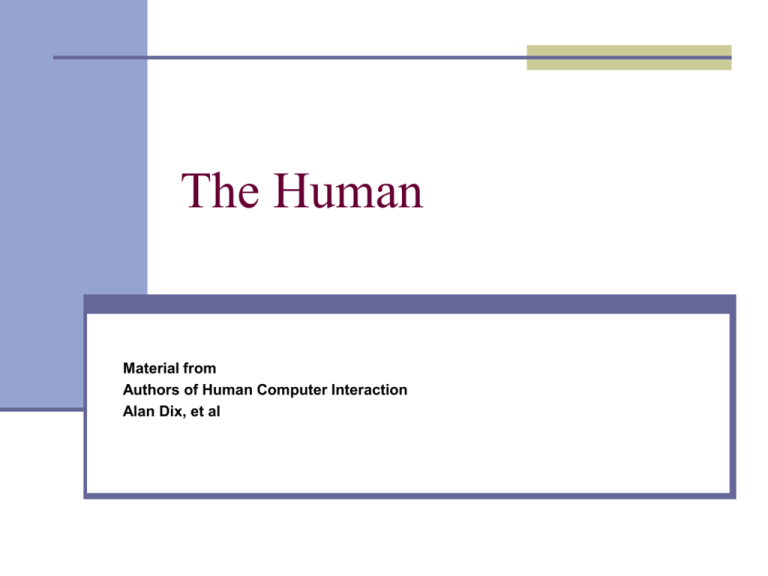
The Human Material from Authors of Human Computer Interaction Alan Dix, et al Overview Human can be viewed as an information processing system. A simple model: information received and responses given via input/output channels information stored in memory visual, auditory, haptic sensory, short-term (working), long-term information processed and applied in various ways reasoning, problem solving, skill acquisition, error Overview Capabilities of humans in these areas are important to design, as are individual differences. Input/Output channels Vision Two stages in vision physical reception of stimulus processing and interpretation of stimulus The physical apparatus: the eye mechanism for receiving light and transforming it into electrical energy light reacts from objects; their images are focused upside-down on retina retina contains rods for low light vision and cones for color vision ganglion cells detect pattern and movement Input/Output channels: Interpreting the signal Size and depth visual angle indicates how much of field of view object occupies (relates to size and distance from eye) familiar objects perceived as constant size in spite of changes in visual angle | law of size constancy cues like overlapping help perception of size and depth Brightness subjective reaction to levels of light affected by luminance of object visual acuity increases with luminance as does flicker Color made up of hue, intensity, saturation cones sensitive to color wavelengths blue acuity is lowest 8% males and 1% females color blind Interpreting the signal (cont) The visual system compensates for movement and changes in luminance. Context is used to resolve ambiguity. Optical illusions sometimes occur due to over compensation. Perceptual Organization Perceptual Organization Hearing Provides information about environment: distances, directions, objects etc. Physical apparatus: outer ear | protects inner and amplifies sound middle ear | transmits sound waves as vibrations to inner ear inner ear | chemical transmitters are released and cause impulses in auditory nerve Sound pitch | sound frequency loudness | amplitude timbre | type or quality Hearing (cont) Humans can hear frequencies from 20Hz to 15kHz - less accurate distinguishing high frequencies than low. Auditory system filters sounds - can attend to sounds over background noise. For example, the cocktail party phenomenon. Touch Provides important feedback about environment. May be key sense for someone who is visually impaired. Stimulus received via receptors in the skin: thermoreceptors - heat and cold nociceptors - pain mechanoreceptors - pressure (some instant, some continuous) Some areas more sensitive than others e.g. fingers. Kinethesis - awareness of body position affecting comfort and performance. Movement Time taken to respond to stimulus: reaction time + movement time Movement time - dependent on age, fitness etc. Reaction time - dependent on stimulus type: auditory - 150 ms visual - 200ms pain - 700ms Increasing reaction time decreases accuracy in the unskilled operator but not in the skilled operator. Memory There are three types of memory function. Memory Sensory memory Three types: iconic - visual stimuli echoic - aural stimuli haptic - touch stimuli Constantly overwritten. Information passes from sensory to STM by attention. Selection of stimuli governed by level of arousal. Memory Short-term memory (STM) Scratch-pad for temporary recall rapid access - 70ms rapid decay - 200ms calculate 35 x 6 in your head limited capacity – 7 +/- 2 digits or chunks of memory Memory Short-term memory (STM) chunking – composite items Recency effect - easier to remember items most recently added to STM Interference – other cognitive task confounds recency effect Memory Long-term memory (LTM) Repository for all our knowledge slow access - 1/10 second slow decay, if any huge or unlimited capacity Two types episodic – events and experiences semantic - structured memory of facts, concepts, skills Information in semantic LTM derived from episodic LTM. Long-term memory (cont.) Semantic memory structure provides access to information represents relationships between bits of information supports inference Model: semantic network inheritance - child nodes inherit properties of parent nodes relationships between bits of information explicit supports inference through inheritance works sheep has four legs barks ANIMAL breathes is a is a SHEEPDOG DOG moves has tail is a is a size: medium COLLIE color: [brown/white, black/white, merle] HOUND instance instance tracks is a LASSIE SHADOW film character size: small BEAGLE color: brown/white book character color: [brown, black/white] instance Semantic network model of LTM SNOOPY cartoon/book character friend of CHARLIE BROWN color: brown/white Other models of long-term memory Frames: Information organized in data structure. Slots in structure are instantiated with particular values for a given instance of data. DOG Fixed legs: 4 Default diet: carnivorous sound: bark Variable size: color COLLIE Fixed breed of: DOG type: sheepdog Default size: 65 cm Variable color Models of long-term memory (cont.) Scripts: Model of stereotypical information required to interpret situation or language. Script for a visit to the vet Entry conditions: dog ill Roles: vet examines vet open diagnoses owner has money treats owner brings dog in pays Result: dog better takes dog out owner poorer vet richer Scenes: arriving at reception waiting in room examination Props: examination table paying medicine instruments Tracks: dog needs medicine dog needs operation Models of long-term memory (cont.) Production rules: Representation of procedural knowledge. Condition-action rules - if condition is matched, rule fires. LTM processes Storage of information information moves from STM to LTM by rehearsal amount retained proportional to rehearsal time: total time hypothesis optimized by spreading learning over time: distribution of practice effect structure, meaning and familiarity make information easier to remember LTM processes Forgetting decay - information is lost gradually but very slowly interference - new information replaces old: retroactive interference old may interfere with new: proactive inhibition so may not forget at all memory is selective and affected by emotion can `choose' to forget LTM processes Information retrieval recall - information reproduced from memory. Can be assisted by cues, e.g. categories, imagery recognition - information gives knowledge that it has been seen before. Less complex than recall information is cue. Reasoning (cont.) Inductive generalize from cases seen to cases unseen. E.g. all elephants we have seen have trunks therefore all elephants have trunks. Unreliable: can only prove false not true. However, humans are not good at using negative evidence. e.g. Wason's cards. Reasoning (cont.) Abductive reasoning from event to cause. e.g. Sam drives fast when drunk. If I see Sam driving fast, assume drunk. Unreliable: can lead to false explanations. Problem solving Process of finding solution to unfamiliar task using knowledge. Several theories. Gestalt problem solving both productive and reproductive productive problem solving draws on insight and restructuring of problem attractive but not enough evidence to explain `insight' etc. Problem solving Problem space theory problem space comprises problem states start with initial state… move to goal state problem solving involves generating states using legal operators heuristics may be employed to select operators e.g. means-ends analysis largely applied to problem solving in well defined areas, e.g. puzzles rather than knowledge intensive areas Problem solving Analogy novel problems are solved by using knowledge from a similar domain in new domain - analogical mapping analogical mapping may be difficult if domains are semantically different Skill acquisition Skilled activity characterized by chunking - lot of information is chunked to optimize STM experts use conceptual rather than superficial grouping of problems - information is structured more effectively Skill acquisition Model of skill acquisition: ACT* 3 levels of skill learn general purpose rules to interpret facts develop rules specific to task rules are fine-tuned | skilled behavior Mechanisms for moving between these proceduralization - level 1 to level 2 generalization - level 2 to level 3 Errors and mental models Types of error slips - change to aspect of skilled behavior can cause slip incorrect understanding when building mental models. If wrong (different from actual system) errors can occur. Individual differences long term - sex, physical and intellectual abilities short term - effect of stress or fatigue changing – age Ask: will design decision exclude section of user population? Cognitive Psychology and Interactive Design Some direct applications. e.g. blue acuity is poor so blue should not be used for important detail. However, application generally requires understanding of context in psychology understanding of particular experimental conditions

